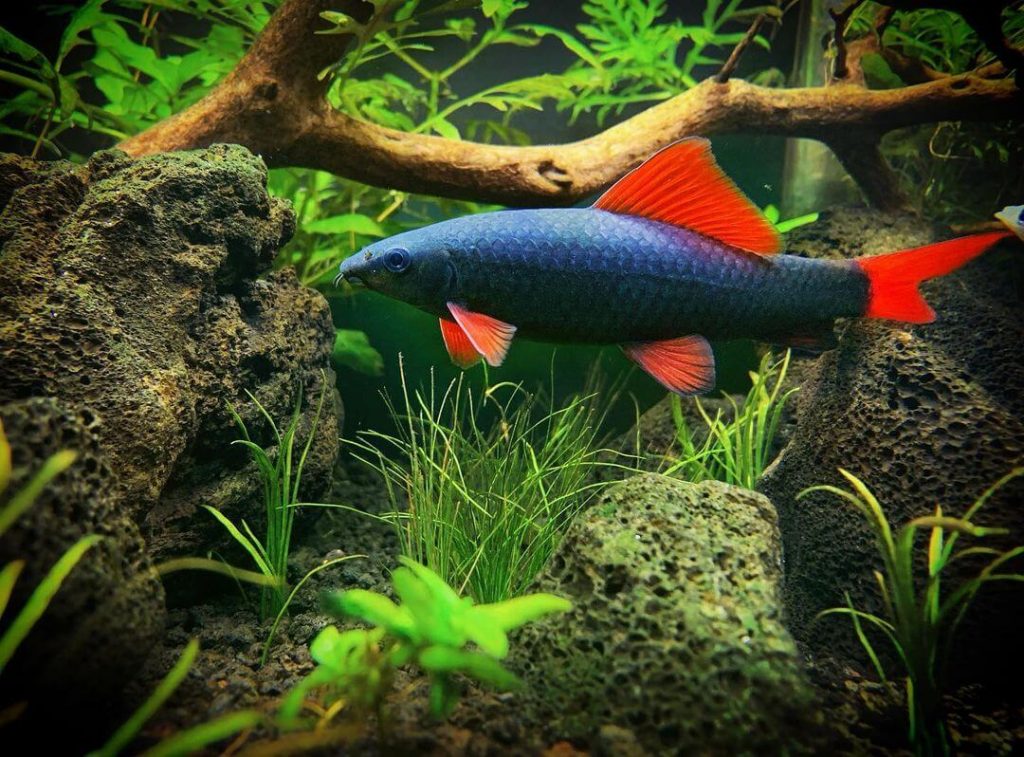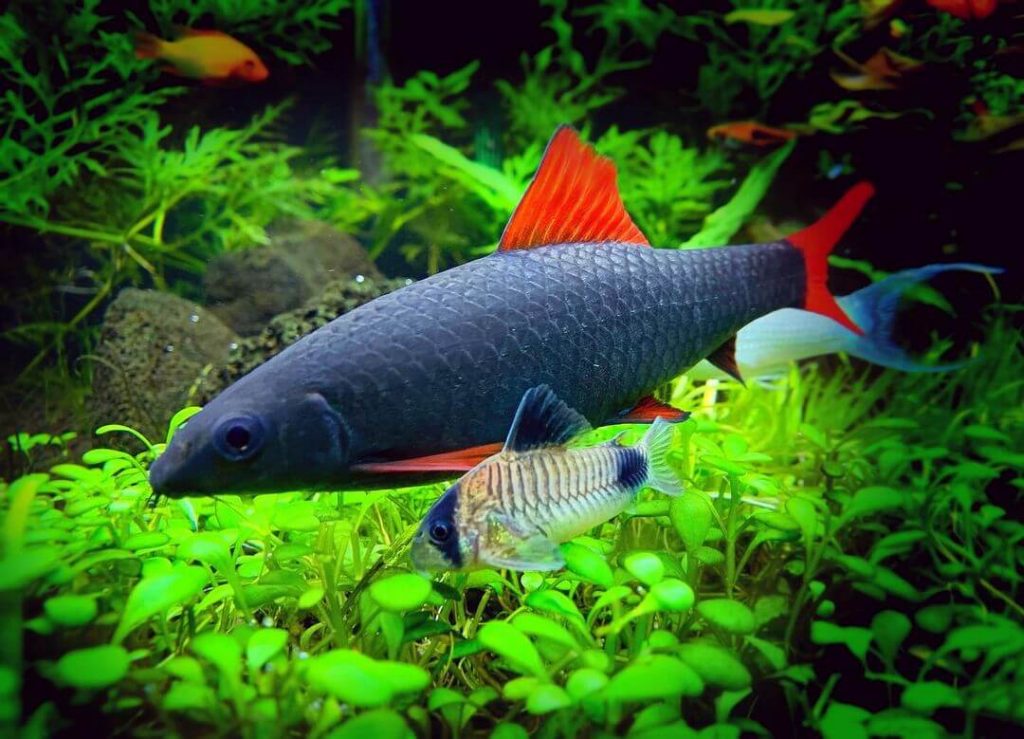Are you thinking about adding a rainbow shark to your freshwater tank? The good news is that this shark species is not too difficult to care for. With a little diligence and determination, we would say that someone with a few years of experience can keep them!
Sometimes also called Red Fin Sharks or Ruby Sharks, this tropical fish come from Thailand. They are known for their vibrant colors, namely the vivid red fins and tail that will look beautiful in any aquarium.
Other than that, rainbow sharks are also known to be quite aggressive and territorial, although not overly so. Let’s look at some care requirements for this species, as well as appearance, tank mates and compatibility, and breeding.
| Category | Rating |
| Scientific Name: | Epalzeorhynchos frenatum |
| Common Names: | Rainbow shark, redfin shark, rainbow sharkminnow |
| Care Level: | Easy to Moderate |
| Temperament: | Semi-aggressive and quite territorial |
| Size: | Up to 6 inches |
| Color: | Grey body with red fins and tail |
| Lifespan: | Up to 8 years |
| Diet: | Omnivore |
| Family: | Cyprinidae |
| Minimum Tank Size: | 50 Gallons |
| Tank Setup: | Requires plants, rocks, and hiding places (caves) |
Table of Contents
Overview

Before going in-depth, we should start with a brief summary to understand the rainbow shark better. As tropical cyprinids, they may not be the easiest fish to care for. However, aquarists who have several years of fish-keeping experience should do just fine.
This fish was first found in the tropical waters of Southeast Asian rivers. Their pronounced dorsal fin is partly what gives them the name of “shark”, but one should not ignore their semi-aggressive nature too.
Meanwhile, many hobbyists choose the Rainbow Shark for their grey and red coloring of their bodies. These omnivores can generally grow up to 6 inches and live between 5 to 8 years. The good thing is that they’re quite cheap and easy to purchase, at only around $3 for one fish!
Our top tip for keeping these freshwater aquarium sharks is to ensure that there are enough nooks and crannies in your tank. These hiding places will help alleviate much of their territorial behaviors.
Appearance
So how do they look like? They have a dark grey body with brightly colored red fins and tails. This stark contrast can provide a vibrant addition to your tank, which is one of their appeals. They also have a long and flat belly with a pointed snout, while the upright dorsal fin is one feature that no one could miss.
In terms of size, they are not very big and will grow only up to 6 inches in length. You can’t distinguish younger fishes who have not sexually matured by their gender. As adults, mature females display thick bodies while male fishes will have tiny black lines on their fins. The males will also look brighter, while generally thinner in build.
You may have heard of the Albino Rainbow Shark, which is a popular variety in the market. They also have vivid red fins, but white bodies instead of grey.
Typical Behavior
One of the reasons why this species is not exactly beginner-friendly is because of their naturally aggressive and territorial behaviors. This dominance becomes more prominent as the fish grows larger. They can bite and chase other species. On the other hand, juvenile rainbow sharks tend to be timid and enjoy hiding.
Not only that, they are notorious for loving algae and can be added to keep your tank sparkling clean. This is because these fishes swim actively, although only stay near the bottom of aquariums. Ensure that there is enough space for them to swim around.
As they are bottom dwellers, you should note that they may not get along as well with other species who live on the bottom. Whereas fishes in upper waters should not have any problem co-existing with rainbow sharks.
Whilst they are peaceful with fish that dwell in higher water, they are known for fighting with bottom-dwelling fish, including their own kind. To ensure as few conflicts as possible, you should provide a larger tank with a lot of hiding places. This could be caves or other types of décor.
Lastly, we do recommend keeping a lid on top of your aquarium. They may not be known to jump, accidents like these are not unheard of! Especially when you first move them inside a new tank.
Habitat and Tank Requirements
Moving on to the tank requirements and habitat that best suits this fish, don’t forget that they are tropical freshwater fish, above all else!
In terms of tank size, try to provide at least 50 gallons of water and enough horizontal space. We do not recommend having multiple of them in a single aquarium. But if you do, it should be a minimum of 125 gallons. In a smaller tank where rainbow sharks are unable to swim around freely, they will display even more intense territorial and aggressive behaviors.
On a similar note, ensure that there are plenty of hiding spots. Vary between caves, driftwood, rocks and hollowed woods. Adding plants and dense vegetation is also a good idea. This will help minimize conflict and aggression.
When it comes to substrate content, the best thing to do is to mimic their natural habitat: tropical rivers. Be careful with gravels, as they are quite sharp and may injure the fish. With that said, fine gravel should work well!
Rainbow Shark Tank Conditions
Habitat and environmental setting aside, tank conditions are just as important. This species has a rather particular condition where they can survive. The Rainbow Shark thrives in waters of 75-81°F, the pH level of 6.5 to 7.5, and hardness between 5 and 11 DH.
It’s crucial to make sure that the pH in your tank as stable as possible. Fluctuations and sudden changes may trigger more aggression. Water movement and lighting are best at moderate and medium levels. Indeed, nothing too crazy or unusual!
Tank Mates
When talking about compatibility, you should know that Rainbow Sharks are not the most peaceful species. They are not the perfect or docile community fish, as they can be quite territorial.
Fishes like the Marbled hatchet fish and Otocinclus catfish are particularly shy and would not be suitable tankmates for them. That’s because they like to claim a certain area of the tank and will chase away those who come close.

Choosing the right tankmate for a rainbow shark can be tricky. But the general rule of thumb is to keep away from species that look similar to them and bottom dwellers. This includes Bala Sharks!
Species that tend to stick in the higher waters will do well, as well as those that are peaceful but not easily intimidated. We recommend Gouramis, Rainbow Fish, and Barbs.
When setting up your aquarium ecosystem, it may help to place your Rainbow Shark last. This way, they cannot claim an entire empty tank as their own and therefore be even more territorial.
Can You Keep Rainbow Sharks with Other Rainbow Sharks?
You may have concluded by now that it is wise to keep Rainbow Sharks alone and never together with fellow Rainbow Sharks. The fact is they simply do not like living with their own kind!
Even in the wild, this species is known to be very solitary. This problem will escalate in the constricted space of an aquarium and the larger fish will chase the smaller one. Younger ones may get along just fine, but it’s best to separate them as they age and become more territorial.
While it is not recommended, it is not impossible either. If you want to have more than one of them in the same tank, ensure there are at least 5 and never just 2 of them. This will prevent the dominant fish from chasing only one of the weaker ones. Also, remember to provide as big a tank as you can!
What Do Rainbow Sharks Eat
As omnivores, you can feed them either plants or meat. Their wild compatriots tend to eat anything, from decaying plants and algae to insect larvae and Zooplanktons. They certainly aren’t fussy eaters, but make sure that any food for them can sink to the bottom.
Their easy dietary requirement is one of the good things about keeping Rainbow Sharks. You can provide flake foods, frozen foods, pellets, vegetables, and live foods. However, it is still recommended to keep this varied, which will help them build a stronger immune system and live longer.
To ensure vibrant shades in their red fins, feed them plenty of live meats like bloodworms and brine shrimp. The frozen variety is fine too. If you have juvenile sharks, then this is even more important, as you wouldn’t want them to be stunted or dull.
Spread the food over 2 to 3 feeding times each day, which you should aim to keep around 5 minutes. Any leftover food after this period is a sign of overfeeding. Therefore, keep track of this every time and you will eventually figure out the perfect portion for your Rainbow Shark.
Rainbow Shark Breeding
Breeding these sharks in a home aquarium is almost always unheard of. This is mainly due to their aggressive nature, especially when they are living in a restricted space. Most Rainbow Sharks in the commercial market have been bred in special farms.
But what about those in the wild? Their natural breeding period is around October until November, though this could vary with the changing season. Much like other fishes, the female fish will lay eggs while the males fertilize them. It will take only a week or less for these eggs to hatch!
Should You Get A Rainbow Shark?
That is most of the things you should know about Rainbow Sharks, especially if you had been considering of keeping them. So, should you get a Rainbow Shark for your freshwater tank?
At the end of the day, they are often an excellent addition that can provide a pop of color and attitude to the community. Just remember not to keep them with similar-looking species or even others of their kind. As long as you house them with the right tankmates, preferably not fellow bottom dwellers, they should not give you too many challenges.
In addition, their active swimming and beautiful color can be extremely appealing. It’s also important to make sure that you have the right tank and water conditions. This will keep them healthy and happy!
However, we do recommend that you have at least several years of experience in this hobby. After that, Rainbow Sharks should be fairly easy to care for, and a lot of joy to look at!






